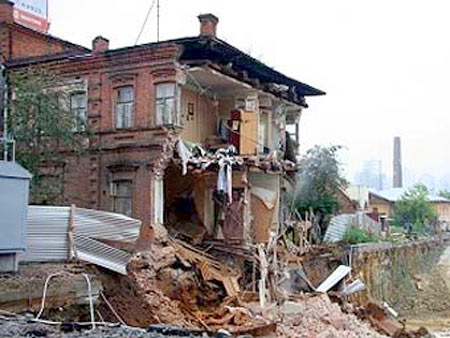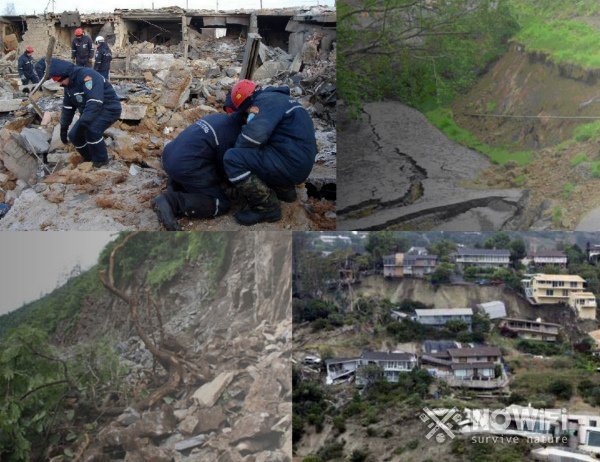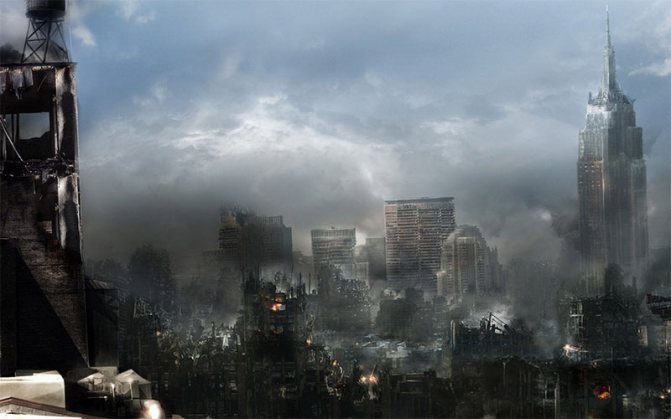Actions in case of building collapse
The collapse of a building, complete or partial, refers to emergency situations that result in significant harm to health, including loss of life, as well as significant material damage. The reasons for such situations are different.
The consequences of sudden building collapses can paralyze the activities of housing, communal and energy systems for a long time, leading to fires, explosions, and rubble. Surviving people lose not only their belongings, but also their shelter.
Characteristics of collapses and their main causes
- poor quality of materials used
- the occurrence of corrosion and aging of building structures, leading to a decrease in their performance characteristics
- natural phenomena such as rainstorms, hurricanes, earthquakes, landslides
- Changing the original position of the entire structure relative to its foundation. These may be tilts, displacements or subsidence.
- First you need to calm down and even out your breathing. Remember that there is a limited amount of oxygen under the rubble.
- Do not make sudden movements, save your strength and energy. Remember that a person can live long enough without food and water if energy consumption is reduced.
Preventive Actions
In the event of an emergency, you should know where the power switches and water and gas supply shut-off valves are located. Often the cause of building collapse is mistakes when a gas leak occurs. In this case, it is prohibited to use matches, lighters, and candles. Do not turn on electrical appliances; any spark can lead to an explosion. The correct action would be to ventilate the room and call the gas service.
Pockets, landings, and emergency exits on balconies should not be cluttered with heavy objects.
Sudden building collapse: how to behave?
When leaving the premises, use only the stairs. Try to sharply and firmly suppress panic behavior in other people. You cannot jump from windows or balconies that are located above the 1st floor. When you go outside, try to move as far as possible from the building being destroyed.
If you cannot leave the room, you should open the door and find a safe place. These include: corners between walls, doorways in load-bearing walls, frame beams. You can also use a cast iron bathtub as a refuge.
If you don't have any time, use a table. It can protect you from debris and dust. If a building collapses, cover your ears to prevent damage to your eardrums. The most optimal position is that of the embryo.
If possible, stay away from windows, electrical appliances, and gas equipment. If you have a telephone, use it only to call emergency services.
How to properly provide assistance to victims of the rubble
While in the rubble, remember the places where you heard tapping, voices or moans of people. When approaching the voids, you can only inspect them, but do not try to climb into them.
- Fallen slabs can only be lifted up
Having discovered a living person, but not being able to pull him out from under the rubble, stay nearby and talk until professional rescuers arrive.
There is special literature for rescuers, rules for conducting ASR during the collapse of buildings and structures, you can also study it.
What to do in case of mudflows
As a rule, places prone to debris flows are well known. Therefore, if you are going to the mountains, study your route first (Figure 6).
If the weather service warns of heavy rainfall or intense snow melting, take into account the possibility of a mudflow and do not go to the mountains in bad weather. There is practically no chance of escape if you get into a mudflow, but encountering it can be avoided.
When you hear a roar, immediately rise up from the lowland, at least 100 meters, staying away from river beds and streams.
The population living in dangerous areas should be prepared to evacuate when notified of a mudflow. You need to collect documents, take money and medicine, a small supply of water and food. When leaving the house, turn off the gas and electricity, close the windows and doors tightly. In case of a quick evacuation, move to a safe place on higher ground, helping physically weaker people.
Figure 6. It is almost impossible to get out of a mudflow, so you need to do everything possible to avoid encountering it.
At the same time, you need to know that stones that threaten life can be thrown from a moving stream over long distances. If you are injured as a result of an emergency, try to provide yourself with first aid by applying ice (wet cloth) or a pressure bandage to the affected areas of your body. If possible, provide assistance to the victims around you, assist in the removal of rubble and drifts along the path of the flow.
Actions in case of building collapse

Building collapses pose a mortal danger to people inside the structure and, to some extent, threaten those outside. The causes of building collapse can be:
— explosion or mechanical shock;
— soil subsidence and foundation displacement;
- design defects of the building itself;
— meteorological disasters in the form of hurricanes, tornadoes, tsunamis, floods.
The problem of self-rescue and saving people in these conditions is that collapses occur in most cases suddenly and very quickly. The first signs of building destruction may be:
- sudden cracks in the walls, floor and ceiling;
— signs of an explosion or mechanical shock.
In this situation, it is necessary to remember that exiting a multi-story building will take a lot of time, which, most often, those in distress do not have. At the slightest sign of collapse, it is necessary to take shelter in those places where damage from debris is least likely. Such places in a building include window and door openings, corners formed by main (load-bearing) walls. In this case, children must be pressed face to face, thus protecting them from possible injuries.
Moving in a dilapidated building is extremely dangerous, since its destruction can continue at any moment. Therefore, if possible, it is better to attract the attention of rescuers by shouting and wait for help. You should also not return to a destroyed house in search of property and documents.
A safe distance from a collapsing building is considered to be a distance equal to its height. In places of such accidents, open fire should not be used, since these accidents always lead to the destruction of gas communications. It is also prohibited to use water supply in the disaster area, because the destruction of the water supply and sewerage systems can lead to water contamination.
In such a situation, especially if there is massive destruction of houses, it is everyone’s duty to assist the Ministry of Emergency Situations in every possible way in clearing the rubble and helping the victims.
mchs-orel.ru
Danger and negative consequences
The danger of the described emergency phenomena consists in impacts of rocks and stones, large blocking of open space with rock masses, and a risk to human life (Figure 3).
Among the negative consequences of these emergencies are the destruction of roads, highways and communications (pipes for supplying water, gas and electricity). Combined with the destruction of houses and even the complete destruction of populated areas, this natural disaster poses a serious danger to the population.

Figure 3. The danger of landslides is that they completely destroy all objects in their path
In addition, landslides, landslides and mudflows provoke modifications of the landscape - changes or blocking of river beds, swamping of fertile lands, destruction of agricultural plantings, which is often accompanied by the death of people and animals.
Sudden building collapse. Behavior rules
Complete or partial sudden collapse of a building is an emergency situation that arises due to errors in design, due to deviations from the project during construction work, violations of installation rules, when commissioning a building or its individual parts with major deficiencies, or violation of rules operation of the building, as well as due to a natural or man-made emergency.
The collapse of a building can often be facilitated by an explosion resulting from a terrorist act, improper operation of household gas appliances, careless handling of fire, or storage of flammable and explosive substances. Recently, cases of building roofs collapsing as a result of large amounts of snow have become more frequent. The sudden collapse of buildings leads to fires, destruction of utility and energy networks, the formation of rubble, injuries and deaths.
According to statistics, out of 100 people. About 5 victims die in the rubble every hour. People can live under the ruins for up to 2-3 weeks if they are not injured, if there is enough air and the air temperature is normal. The threshold of survival for everyone in extreme situations depends on preparedness, which is facilitated by the study of the discipline of BJJ.
Rules of conduct In the event of a sudden building collapse:
- do not panic and do not lose heart, remember, you will definitely be saved;
- If possible, provide first aid to yourself and the injured;
- try to adapt to the situation, look around, look for a possible way out;
- if you have a mobile phone, contact the rescue service at 112 (the number also works if there is no money on your phone account) and report your situation;
- give signals for help by voice, light (only a flashlight), knocking (with various hard objects, preferably metal);
- if you are crushed, know that rescuers periodically stop work, at this time you need to move any object, preferably metal, with the help of special instruments and trained dogs they will determine your location and come to the rescue;
- remember: a person can withstand thirst for up to 5 days and hunger for up to 45 days, if he does not waste energy.
- mistakes that were made during the design of the building
- Unscrupulous execution of installation and construction
- additional, not provided for by the design, loads on structures, as well as the impact on them of oxidizing agents, low or high temperatures, vibration, and vapors.
- Violation of established operating rules for various structures can lead to spontaneous combustion, explosions, and fires (for example, a domestic gas leak).
- Act of terrorism
- Damage to some structures, as well as their elements, which can lead to deformation of the building and its partial collapse.
- Focus on your own sensations: whether you feel pain, whether you can move your legs or arms, whether you can change location, whether you are injured and how badly.
- In addition, you should look around and listen. Perhaps there will be another person next to you and you can support each other.
- Give sound or light signals. You can find a small object that you can use to tap on the wall.
- Do not use heavy equipment to move collapsed structures
Compartment syndrome. A person who has been in a rubble for a long time, crushed by heavy slabs or reinforcement, without blood flow, gets injured in his tissues. As a result, toxic waste products of the body accumulate at the site of injury. If the load is removed from the victim immediately after discovery, the toxins will rush into the blood like an avalanche. The kidneys are unable to cope with such a flow of toxins; they refuse to work and death occurs.
Therefore, before removing the slab from the victim, doctors are invited to begin carrying out resuscitation procedures even before complete release: administering special drugs through a drip. Volunteer helpers should behave the same way. If there are no medical workers, then it is necessary to apply a tight bandage to the entire crushed limb, and after release, urgently deliver the victim to a medical facility.
Do not release the victims immediately from the entire load without doctors - this will lead to his death
studopedia.ru
Latest publications:
According to statistics, in the event of a partial collapse of a building, many victims are injured and die as a result of panic and chaotic actions, as well as as a result of improper assistance provided by passers-by or witnesses. How to behave in the event of a house collapse, how to help people trapped under the rubble before rescuers arrive, we will consider further.
Most often, the collapse of a building in peacetime can be caused by:
Types of building collapses
Depending on what damage occurred as a result of the destruction of the building, it can either be restored by strengthening or replacing damaged elements, or structures that cannot be repaired can be dismantled.
It is impossible to prepare in advance for emergency events. However, there are a number of steps you can take in advance that will significantly save time and make your situation easier in case of an emergency.
In an office building, you should familiarize yourself with the evacuation plan. You need to know exactly where the emergency exits are. A fully stocked first aid kit and a refilled fire extinguisher, such as carbon dioxide, should be kept in an easily accessible place. All hazardous substances that can easily ignite or pose a threat to human life must be kept in a separate, isolated room.
Your family members should know the basic rules of what to do if a building collapses. Have an introductory conversation with young children about this topic in advance. Talk to them about the basic procedure for evacuating a building if it collapses. Keep basic documents and medical records for all family members in a separate folder.
If you feel the vibration of the walls and signs of imminent collapse, you should immediately leave the building. Take documents, a flashlight and spare batteries with you (you should have all this in one place; you may not have time to look for it).
What to do if you find yourself buried under rubble
If you are a person who has the right to make independent decisions to save people trapped under the rubble, then you need to remember two basic principles:
fireman.club
Causes of collapse of structures
The reasons can be very different. For example, destruction may occur due to poor quality materials used in construction, or the project itself was made with errors. Builders and installers could also do their work dishonestly (Figure 2).
It also happens that the destruction of a building occurs not because of a person, but because of surprises from nature. For example, landslides, earthquakes, and hurricanes can significantly damage what has been built by man.
In addition, it could be that certain structural loads were not taken into account during construction. This could happen either due to the negligence of people who did not take into account local natural phenomena, or natural phenomena acquired new characteristics over the years. This has happened quite often over the past decades. Either hail in May, or grass in December. Therefore, it is quite possible that at the time of designing this house there were no earthquakes in that area, but 10 years later everything changed, not for the better.
Another common cause of major destruction is the use of buildings whose service life has long expired. In this case, the characteristics of building materials and structures in general are significantly reduced. Or there may be a different situation. Someone somewhere saved money and built it without taking into account certain loads, such as vibrations or oxidizers, temperature differences. As a result, the building will not last long.

Figure 2. Quite often, collapses are provoked by people themselves
Sometimes explosions are deliberately organized by terrorists, or children left unattended by their elders may be “playing around.” Well, the most common reason is a violation of the rules for operating various communications and the structure itself. Most often we hear about explosions due to gas leaks, which leads to severe destruction.
What to do if you can’t get out of a falling house?
Sometimes it is too late to escape or there is no way to escape from a falling building. Then you will have to fight for your life right on the spot. Take the safest place. These can be openings in main walls, main corners of a building, under frame beams. You can hide under a table, which will protect you from falling debris. It is better to open the apartment door so that the rescuers can get to you. Cover your head with your hands to prevent debris from falling on it. Children should be held face to face to protect them from possible injury.
Stay away from windows, electricity and gas. It's better to turn them off to avoid danger. If a fire occurs, immediately extinguish it with available means. Do not use matches if there is a risk of gas leakage.











